|
|
UTILIZING THE "SZARVASI-1" ENERGYGRASS FOR ENERGETICAL PURPOSES
1) The "Szarvasi-1" energygrass as solid fuel.
There is increasing importance in using lignocellulose fuels /eg.: energyrass/ for heat and electricity supply in Europe and worldwide.
The economicality and competitiveness of cultivating and utilizing vegetable energy sources can be determined according to their agriecological and energetical features, and to the extent of their productivity. Compared to the traditional tree species and other vegetable energy sources, the drymaterial-output of the energygrass in the phenophase of its flowering shows considerable productivity /Table 1./
Laboratory examinations confirm that the "Szarvasi-1" energygrass has favourable energetical features, because its thermal value approaches or exceeds the thermal value of the national brown coals, wood and straw kinds.
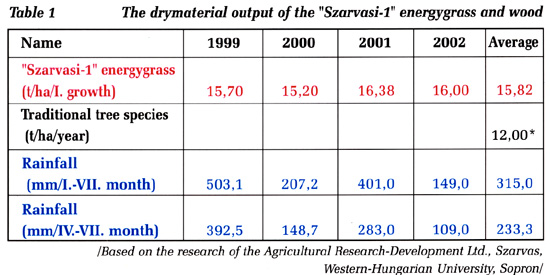
Among the examined energy sources, the unit energy cost is the lowest in the case of the energygrass /Table 2./ Based on the components of the energygrass it
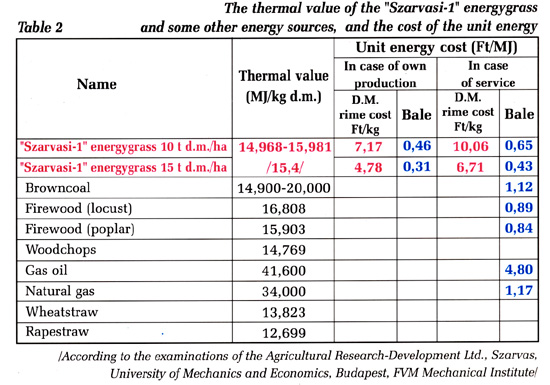
is ascertainable that its sulphur content is little /0,12%/, only half of the sulphur content of the coal, so in case of burning it, the S02 letting out is minimal. As opposed to the 12-15% ash content of the coal, it contains little
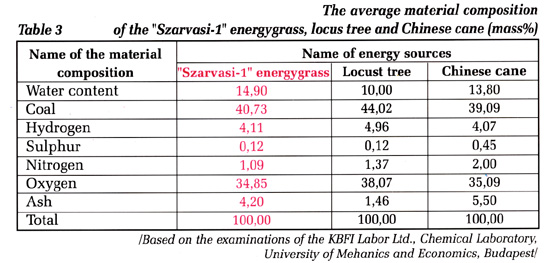
quantity /4,2%/ ash, which can be utiliscd due to its potassium content in the compensation of the soilpower. According to the examinations of the Danish Technological Institute, there was not any softening in case of the ash at 1000 C.
The burning of the energygrass can happen after the appropriate preparation treatments eg.: compression, cutting /baling, briqueting, pelleting/.
"Szarvasi-1" energygrass in bales:
"Szarvasi-1" energygrass briquet and pellet:
Pellet heated boiler:
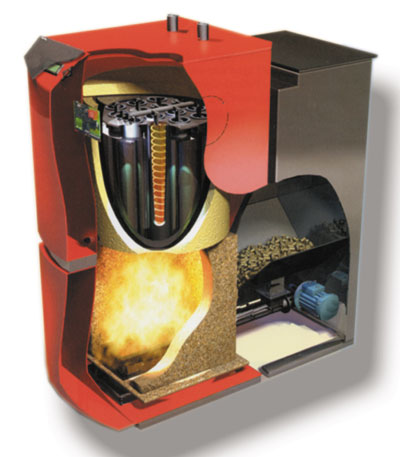
From the burning technical point of view, it has more favourable features compared to the straw kinds
/Based on the examinations of ÉGSZÖV Rt., Budapest, OPTIGÉP Machine-manufacturing and Trading Ltd. Békés/
2) The production of pyrolise gas from energygrass
Physical conditioned energy sources can be produced from the different forms of biomass, so from energygrass as well, and they have increasing importance. The "Szarvasi-1" energygrass can be one of the cheapest base material of vegetable gas due to its big drymaterial content, favourable material composition, cultivation and harvesting.
There were examinations in the laboratory of the Danish Technological Institute /DTI Chemical Technology Institute/ in order to find out the the quantity, composition and thermal value of the gas that was produced during the thermic decomposition of the energygrass. The examination results can be summarized as the followings:
Gas production:
The biggest gas production of the "Szarvasi-1" energygrass is at 350 C. At 325 C, an exothermic reaction can be detected with intensive gas production /Figure 1/
The second peak during the gas production process was detected at 500 and 700 C pyrolise temperature.
The gas formation was relatively equal in other temperature domains. During the pyrolise 197,5 Nl grassgas arose in 1 kg drymaterial /Figure 1/
The detailed results can be seen in Table 4.
The values of Table 4 demonstrates well the processes during pyrolises:
- The main process is that moisture escapes under 200 C,
- Between 450-650 C the formation of methane increases and shows high level,
- Between 550-1000 C the H2 content of gas increases, which will become stable at a very high level.
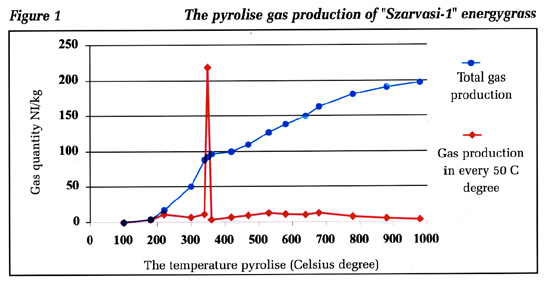
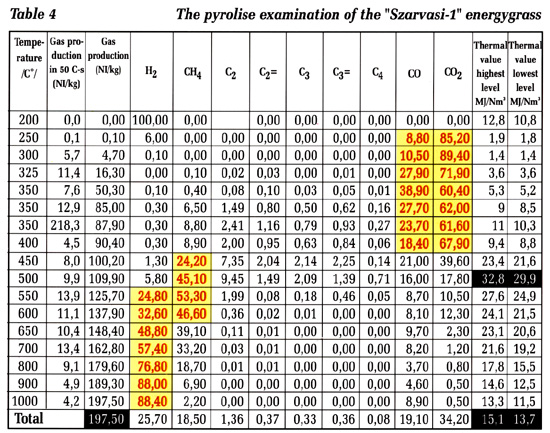
Thermal value
The thermal value produced from "Szarvasi-1" energygrass changes according to the temperature of pyrolise /Figure 2/ The CO2 formation is relatively big at the beginning of pyrolise /250-400 C/, which can reduce the thermal value. The highest thermal value was found at a relatively low 500 C pyrolises temperature. The highest thermal value was 15,1 MJ/Nm3, the lowest was 13,7 MJ/Nm3 with reference to the the total gas production /Table 4/.
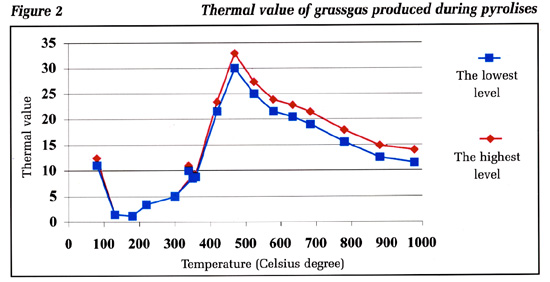
3) Biogas from energygrass_
The biogas is the anaerob decomposition of biomass, so it arises as a result of the biological processes. All organic materials are suitable for producing biogas /except the products of the organic chemical industry/.
Useful basic materials can be:
- Straw and thin dungs, waste, derive from agriculture,
- thin and solid by-product, wastes, sewage derive from the communal and food industry,
- Vegetable /except woody-stem plants /energy sources /eg.: energy grass/ The biogas contains approximately 60-70 % methan, 30-40 % CO2.
The thermal value is 22-23 MJ/Nm3/.
The grasses recommended for energetical utilization deserve special attention from the raw materials suitable for biogas production. /Table 3/.
The "Szarvasi-1" energygrass and other perspectivical nominees under improving in their green condition, and mixed with traditional cattle and thin dung, can be utilized for biogas production very efficiently.
Table 3 demonstrates very well that from the examined biomass forms, the energetically utilizable grasses have the shortest fermentation time, and their gas production is also excellent since the gas quantity produced during the only 15-20 day rotting time exceeded the 0,5 m3/kg dry material order. The use of biogas is wide, the left over material from production can be used for the compensation of soil energy /biodung/.
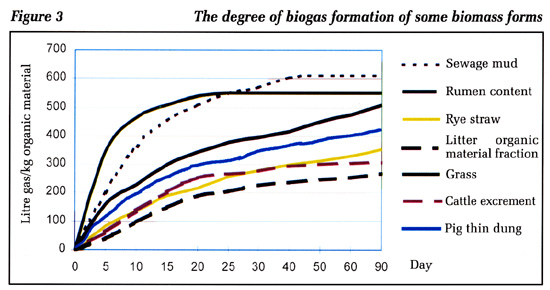
|
|
|


